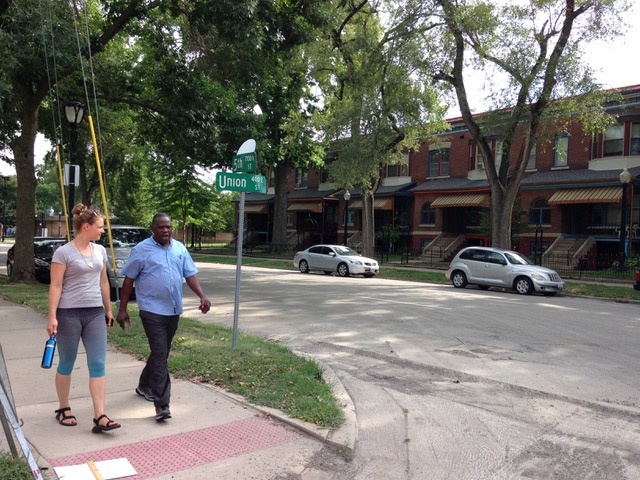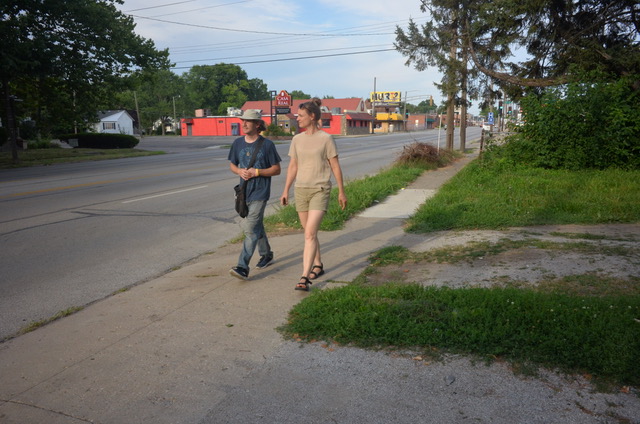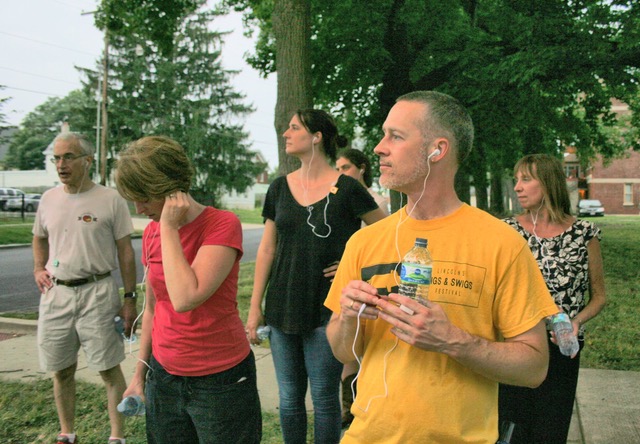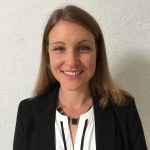You Are Here: Astrid Kaemmerling
Allison Lacher and Jeff Robinson work collaboratively as artist-curators and organizers in Springfield, Illinois. For over seven years, they have developed contemporary arts programming at the University of Illinois Springfield…

Allison Lacher and Jeff Robinson work collaboratively as artist-curators and organizers in Springfield, Illinois. For over seven years, they have developed contemporary arts programming at the University of Illinois Springfield Visual Arts Gallery, DEMO Project, and the Terrain Biennial at Enos Park. Lacher and Robinson reached out to seven creative and cultural purveyors whom they have worked with over their tenure in the capital city to reflect on their experience there — that is to say, “here.” The resulting texts together form “You are Here,” a new venture from the collaborative duo in partnership with Sixty Regional and made possible with support from Illinois Humanities. As is typical of their curatorial approach, Lacher and Robinson have extended freedom and latitude to each contributor, resulting in texts that take a variety of forms and offer wide-ranging glimpses into what it is like to work here in the flyover region of the United States, in the perceived rural Midwest, in Central Illinois, and, at the heart, here in Springfield.
Walking Enos Park: Community and Urban (Re)development through the Arts in the American Midwest
by Astrid Kaemmerling, Ph.D.
I came to Springfield in 2017 as one of two inaugural artists at the newly developed Enos Park artist residency, having been awarded a generous fellowship to host, and later exhibit, what I call a Community Walking Laboratory. My residency consisted of 30 + one-on-one individual walks with residents, participation in community meetings, and the creation of an audio-walk, with the end goal to exhibit the community research at the University of Illinois Springfield Visual Arts Gallery. The residency was designed to support artists, yes, but also to serve as a venue for community revitalization through the resident artists’ contributions, works, and outside perspectives. Specifically, the residency sought artists to “invest in/work with the rich historic context of the neighborhood, work with the immediate community, and shine a light on the increasingly potent potential of the Enos Park revitalization” (Enos Park Homepage, 2/2019). Since 2013, I’ve led and/or initiated more than 50 “walkshops,” to promote and share the model of walking as community practice to heighten civic engagement. In bringing the laboratory to Springfield, I intended to motivate citizens to participate in the redevelopment processes of this neighborhood and initiate more social-just urban planning processes.

Throughout my three month stay, I experienced the neighborhood and (art) community firsthand, and helped activate locals to engage proactively with their own neighborhood and city through the Community Walking Laboratory. In the morning and in the evening, I met walking participants who had signed up for walks. Each walk began and ended on the front porch of the Enos Park artist residency. Every walk was different, as participants chose the route to guide me through the neighborhood, while sharing real and imagined stories about Enos Park and the city at large.
As the weeks went by, and after dozens of walks with individual locals and artists, Enos Park slowly unfolded. Several walking laboratory participants identify, as one resident put it, a “neighborhood with economic and racial diversity where people tend to look out for each other.” I was told we were walking through “the old forgotten West Side, with historic charm and significance,” where some of the houses are on the register of national historic places. “Enos Park was once the most spectacular neighborhood of Springfield, and is fighting its way back to being reestablished for people who have creativity and vision and [who] appreciate the richness of this neighborhood,” another local says. Until recently, however, Enos Park was considered unsafe, and was heavily impacted by the national opioid crisis. It faces issues of economic instability, racism, and segregation. Tara McClellan McAndrew reported in 2013 that, “The city’s retreat from its center and decades of neglect sent the neighborhood spiraling until it hit bottom in the 1980s. Crime, slumlords and dilapidated houses were rampant. […] There is less crime, but it’s still an issue.” However, I personally could not connect to these reports and felt safe walking around the neighborhood in company.
Participants were highly engaged, enthusiastic, and dedicated to improving the neighborhood. To find participants, I was heavily reliant upon the network of the Springfield Art Association, whose support made these walks possible. Likewise, those who walked with me and trusted me to listen carefully were my partners in this project. Gaining that trust and integrating a diversity of voices, particularly those from different socioeconomic and racial backgrounds, proved to be one of the unexpected challenges of my time in Springfield.
Springfield intentionally draws artists from all over the country to spur cultural discourses, actively using the arts as a tool for urban redevelopment. These exchanges are meant to spur equity discourses and social-just urban planning approaches.

What the Springfield community brought to my attention was that they crave economic and racial justice, access to and support for the arts, new infrastructure and civic maintenance, and a preservation of an already existent community consciousness. These concerns transcend the Midwest. But the question in Springfield, as in so many areas of urban redevelopment, is whether the economic value the arts and artists return to the community is being abused in the process of urban redevelopment, or if resources and economic gains are distributed equitably. The arts hold power; the question that the Springfield arts community has to ask itself is how they want to structurally impact the neighborhood, which community voices are represented in the process, and whether they have supporters that make sure that the artists are being professionally empowered. Springfield is actively field-testing community-building processes through the arts, creating models for other cities to follow, and entering a national discourse on the role of arts organizations in urban redevelopment.
The power of walking lies in creative thinking; it allows us to reflect on the past while moving forward. The Community Walking Laboratory activates the people I walk with– artists, or not; mothers,fathers and children; administrators and public figures; retirees — the power of walking is its universality, and its accessibility to most, if not all, citizens. Unfolding the character of a neighborhood and shaping space into place ultimately relies on the memories of its residents. Walking allows us to connect the past with the present, and to realize what is right in front of us — at any given moment — while providing us with time to access personal memories; a momentary union of thought that propels us to move ahead and shape our future. As Rebecca Solnit wrote, walking is “the engagement of the body and mind with the world, of knowing the world through the body and the body through the world.” It is this engagement which the Walking Laboratory tries to promote — in all communities of all types.
It can be hard to quantify the impact, but when I get emails from past participants telling me that they did XYZ after walking the neighborhood, or I receive a letter with a poetry booklet written by a past participant about their neighborhood, I know that the quality of the impact is real. We forget that we have power, that our bodies count because they take up space, and that what we see and experience matters. Sometimes, all it takes is putting on one’s shoes and heading out the door in order to engage with what is right in front of us. It’s empowering to realize that we can shape the places we live in.

Featured image: Astrid Kaemmerling shown walking Enos Park while being led by a participant of the Enos Park Walking Laboratory (2017), Location: 5th Street and Union Street, Enos Park, IL. Photo by Danielle Wyckoff.
References:
Careri, F. (2002). Walkscapes (1st. edition). Barcelona: Editorial Gustavo Gili SL.
De Certeau, M. (1988). The Practice of Every Day Life. London, England:University of California Press.
Fainstein, S. S. (2011). The Just City. Ithaca London: Cornell University Press.
McAndrew, Tara McClellan, Illinois Times, October 2013. https://illinoistimes.com/article-12899-urban-pioneers.html
Pink, S. (2013). Doing Visual Ethnography (Third edition). Los Angeles: SAGE Publications.
Solnit, R. (2001). Wanderlust: A History of Walking. New York: Penguin Books.
Springgay, S., & Truman, S. E. (2018). Walking Methodologies in a More-than-human World: WalkingLab. London ; New York: Routledge.


Astrid Kaemmerling, Ph.D., is a german-born artist, researcher and educator based in New Orleans, LA. Her work spans the genres of visual, performance and media art and strives to connect place memories of the past, such as collected travel experiences, with a critical exploration of specific neighborhoods and selected urban places. Kaemmerling has been exhibited internationally in Germany, Italy, Korea and the United States. She has won several awards and fellowships, and has had residencies at the Cittadellarte-Fondazione Pistoletto, Italy, the Vermont Studio Center, VT, Enos Park, IL and Kala Art Institute, CA. Her writing has been published in peer-reviewed journals and publications. She is the founder of The Walk Discourse, a social practice art project, educational platform and research laboratory that provides room for exchanges about public space. Founded in San Francisco, CA and currently based in New Orleans, LA, the program sets out to playfully and critically engage participants to study the urban and rural fabric through the act of walking. Current artistic research projects include a series of works that investigate “processes of home-building.”